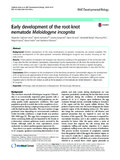Mostrar el registro sencillo del ítem
Early development of the root-knot nematode Meloidogyne incognita
| dc.creator | Calderón Urrea, Alejandro | es_ES |
| dc.creator | Vanholme, Bartel | es_ES |
| dc.creator | Vangestel, Sandra | es_ES |
| dc.creator | Kane, Saben M. | es_ES |
| dc.creator | Bahaji, Abdellatif | es_ES |
| dc.creator | Pha, Khavong | es_ES |
| dc.creator | García Solano, Miguel | es_ES |
| dc.creator | Snider, Alyssa | es_ES |
| dc.creator | Gheysen, Godelieve | es_ES |
| dc.date.accessioned | 2018-08-31T08:07:58Z | |
| dc.date.available | 2018-08-31T08:07:58Z | |
| dc.date.issued | 2016 | |
| dc.identifier.issn | 1471-213X | |
| dc.identifier.uri | https://hdl.handle.net/2454/30352 | |
| dc.description.abstract | Background: Detailed descriptions of the early development of parasitic nematodes are seldom available. The embryonic development of the plant-parasitic nematode Meloidogyne incognita was studied, focusing on the early events. Results: A fixed pattern of repeated cell cleavages was observed, resulting in the appearance of the six founder cells 3 days after the first cell division. Gastrulation, characterized by the translocation of cells from the ventral side to the center of the embryo, was seen 1 day later. Approximately 10 days after the first cell division a rapidly elongating two-fold stage was reached. The fully developed second stage juvenile hatched approximately 21 days after the first cell division. Conclusions: When compared to the development of the free-living nematode Caenorhabditis elegans, the development of M. incognita occurs approximately 35 times more slowly. Furthermore, M. incognita differs from C. elegans in the order of cell divisions, and the early cleavage patterns of the germ line cells. However, cytoplasmic ruffling and nuclear migration prior to the first cell division as well as the localization of microtubules are similar between C. elegans and M. incognita. | en |
| dc.description.sponsorship | This work was funded by grants from the California Agricultural Research Initiative (grant #: ARI/CATI/Calderón-Urrea/Cell Death/03-2-006-31), the College of Science and Mathematics at Fresno State, the California State University Program for Education and Research in Biotechnology (CSUPERB), and the RIMI Facility at Fresno State (development of this facility was funded by NIH-NIMHD grant “Research Infrastructure for Minority Institutions P20MD002732”). | en |
| dc.format.extent | 14 p. | |
| dc.format.mimetype | application/pdf | en |
| dc.language.iso | eng | en |
| dc.publisher | BioMed Central | en |
| dc.relation.ispartof | BMC Developmental Biology (2016) 16:10 | en |
| dc.rights | © 2016 Calderón-Urrea et al. This article is distributed under the terms of the Creative Commons Attribution 4.0 International License, which permits unrestricted use, distribution, and reproduction in any medium, provided you give appropriate credit to the original author(s) and the source, provide a link to the Creative Commons license, and indicate if changes were made. The Creative Commons Public Domain Dedication waiver (http://creativecommons.org/publicdomain/zero/1.0/) applies to the data made available in this article, unless otherwise stated. | en |
| dc.rights.uri | https://creativecommons.org/licenses/by/4.0/ | |
| dc.subject | Cell lineage | en |
| dc.subject | Early development | en |
| dc.subject | Embryogenesis | en |
| dc.subject | 4D-microscopy | en |
| dc.subject | Nematoda | en |
| dc.title | Early development of the root-knot nematode Meloidogyne incognita | en |
| dc.type | info:eu-repo/semantics/article | en |
| dc.type | Artículo / Artikulua | es |
| dc.contributor.department | IdAB. Instituto de Agrobiotecnología / Agrobioteknologiako Institutua | es |
| dc.rights.accessRights | info:eu-repo/semantics/openAccess | en |
| dc.rights.accessRights | Acceso abierto / Sarbide irekia | es |
| dc.identifier.doi | 10.1186/s12861-016-0109-x | |
| dc.relation.publisherversion | https://doi.org/10.1186/s12861-016-0109-x | |
| dc.type.version | info:eu-repo/semantics/publishedVersion | en |
| dc.type.version | Versión publicada / Argitaratu den bertsioa | es |
Ficheros en el ítem
Este ítem aparece en la(s) siguiente(s) colección(ones)
La licencia del ítem se describe como © 2016 Calderón-Urrea et al. This article is distributed under the terms of the Creative Commons Attribution 4.0
International License, which permits unrestricted use, distribution, and
reproduction in any medium, provided you give appropriate credit to the original author(s) and the source, provide a link to
the Creative Commons license, and indicate if changes were made. The Creative Commons Public Domain Dedication waiver
(http://creativecommons.org/publicdomain/zero/1.0/) applies to the data made available in this article, unless otherwise stated.



